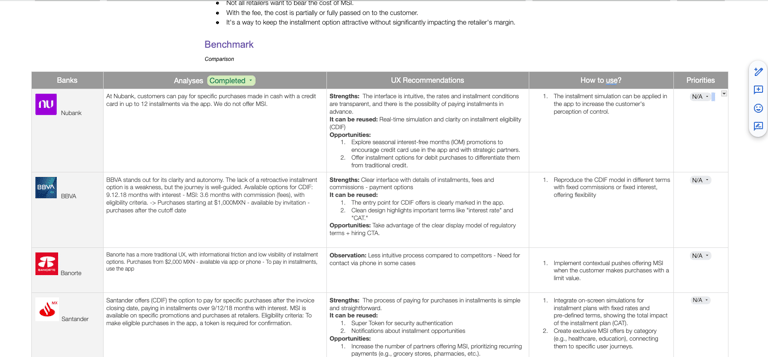The introduction of the fee represents a strategic shift in the financing model: instead of recurring interest, customers pay a single, transparent fee when paying for their purchases in installments. This model simplifies understanding of the total cost, increases financial predictability, and makes the product more competitive in the Mexican market. For users, it means greater clarity and control over their finances; for businesses, it provides an opportunity to increase engagement and adoption of installment plans.
About the project
We identified that many customers viewed interest as confusing or even punitive. The solution was to propose a change to a simpler, more transparent, flat-rate model. The challenge was to translate this charge into a clear, competitive, and scalable experience that could be applied across different purchasing contexts without losing user trust.
Challenges
I worked as a Product Designer responsible for transforming the new fee-based financing model into a clear and engaging customer experience. I contributed to exploratory research and benchmark analysis, helping identify user expectations and behaviors regarding the flat-fee model. Additionally, I mapped user journeys, explored visual solutions, and developed the first version of the interface in collaboration with PMs and stakeholders, ensuring consistency and strategic alignment.
My role
Improve installment plans, helping to transform the interest installment model into a single fee, ensuring customers have a clear understanding of the costs before signing up.
Opportunity
Project Process
Next steps


The project is currently in the research phase, deepening our understanding of user behavior and needs.
Future cycles include new usability tests to validate hypotheses and refine the experience.
After validation, the expectation is to move on to designing final solutions and implementation, ensuring consistency and clarity in the workflow.
Research and Discovery
I began the project with in-depth benchmarking research to understand how other banks in Mexico present fee in the user experience. These insights informed our design decisions and helped identify best practices and risks to avoid.
Journey Mapping
Next, I mapped the current journey to identify opportunities and risks when introducing the fee into the flow. This exercise brought clarity to friction points, allowed for hypotheses to be raised, and guided discussions about what the ideal experience should be.
Wireframe and Prototyping
Based on these insights, I moved on to wireframe and prototyping, designing and organizing an initial experience that clearly structured the fee's inclusion in the flow. This material was essential for visualizing the journey and guiding discussions with the team.
Research in progress
We're currently conducting in-depth research to understand user perceptions of the fee. The results will support the delivery of a clear, simplified, and transparent experience aligned with customers' expectations and real needs.
Collaboration and Agile Development
Throughout the process, we followed an agile approach, working in sprints and constantly collaborating between chapters (PM, BAs, engineering, and design). This close relationship ensured alignment, clarity in decisions, and integration of the project's stakeholders.